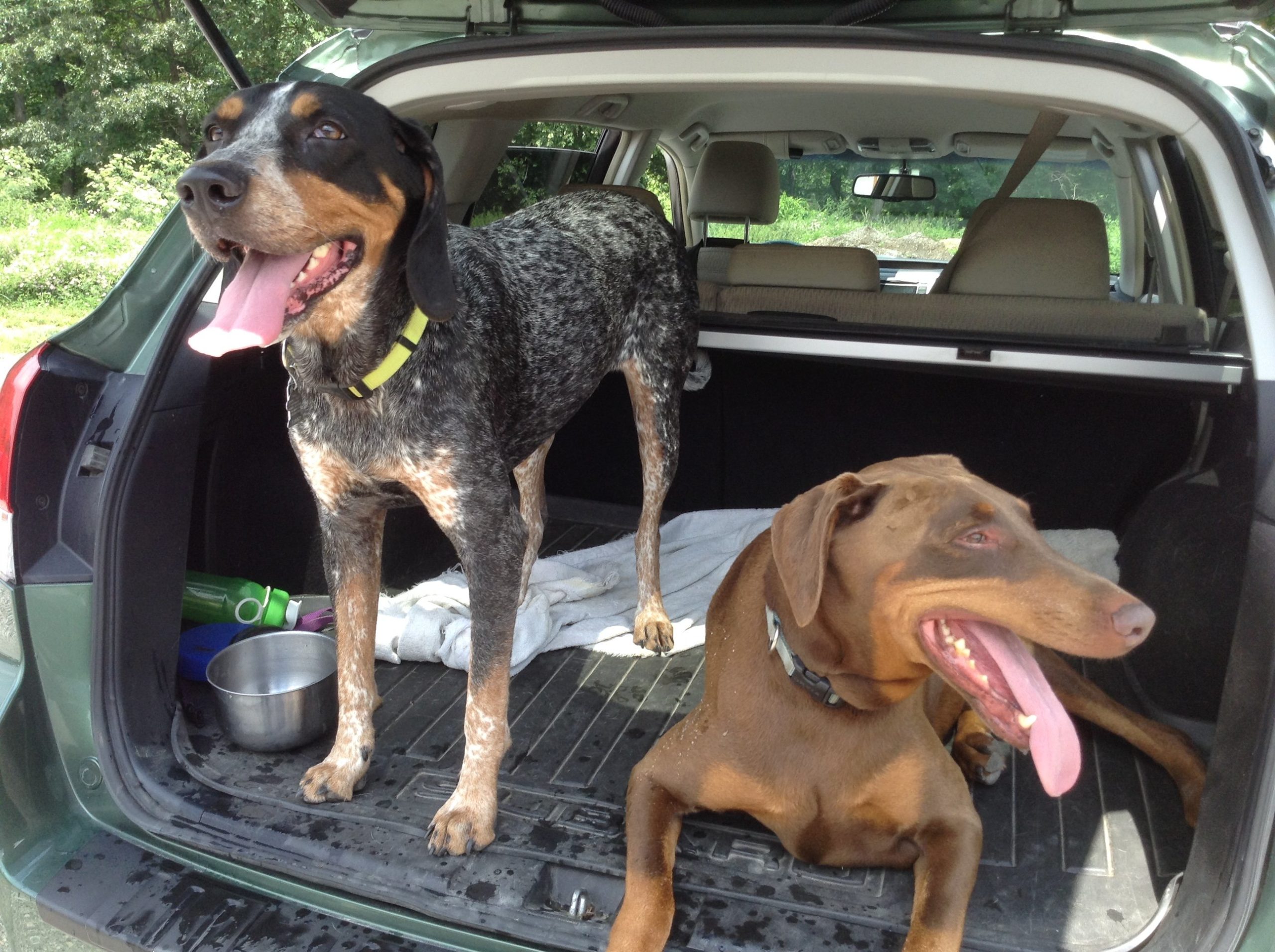Chris Milsom is concerned. She and her husband adopted “a beautiful and sweet five-year-old blue tick coonhound, Paige,” in the spring of 2013. Everything seemed fine. It was not until almost two years later, in the winter of 2015, that PG, as Ms. Milsom and her husband call the dog, “seemed to be scratching a lot all over her body, especially on the outside of her ears.” She was also nibbling at the edges of her legs, and her ears actually developed a few pale patches.

“I tried giving her coconut oil in her food,” Ms. Milsom says, “but that didn’t seem to make any difference. “I tried Tinactin powder, too, dusting the outside of her ears twice a day,” but that didn’t help either. It eventually cleared up, but I never knew why. Now she is scratching again. And I am scratching my head. PG’s housemate, an eight-year-old Doberman, is not having any issues with itching at all, and they eat the same food and sleep on the same dog bed. Do you have any advice for me?”
Ms. Milsom, it is generally not a good idea to diagnose a dog without seeing her in person, but the head of the Tufts veterinary dermatology department, Lluis Ferrer, DVM, PhD, DECVD, feels “quite confident” that Paige is suffering from a classic case of atopic dermatitis.
Defining Atopic Dermatitis for Dogs
Atopic dermatitis is an allergic reaction that takes place on the skin. Most often the offending allergen is something in the airborne environment: dust, pollen, mold, and other offenders. Quite often, the skin itself is believed to be compromised in the first place, which is what allows the allergen to do damage. The outer layer of the skin, the epidermis, has some abnormality in its structure and function, allowing for increased penetration of allergens. Once the allergens are lodged in the skin, a dog who is allergic to them will have an immune response that leads to inflammatory reactions.
The most common manifestation of atopic dermatitis is itching, which is what PG suffers, but believe it or not, she’s one of the lucky ones. In severe cases of atopic dermatitis, the itching can be so bad that it causes scratching, biting, licking, and rubbing incessant enough that it leads to both hair loss and wearing away of the skin itself. Add to that the possibility of nasty bumps, scaly red spots, crusty areas forming over scabs, and thickening and hardening of the skin, and the whole constellation of symptoms can become excruciatingly difficult for a dog to deal with. Bacterial or fungal infections at the “hot spots” can complicate things even more.
One in 10 dogs suffers from atopic dermatitis to one degree or another — it is not all that uncommon. It is also not uncommon for the problem to be seasonal, which is why PG seems to be getting symptoms in the winter only. Molds, pollen, and other irritants come and go with the weather. And it takes a while for a dog to become sensitized to the allergens in a home, which is why PG was living with Ms. Milsom for close to two years, going through her first winter in her new home unscathed, before her itching began the second winter in.
Ms. Milsom, there’s no cure for the problem. It’s genetic, which is why PG has it and your Doberman does not. But you can rest assured that there are treatments that will relieve her discomfort, even eliminating it.
Dog Breeds Susceptible to Dermatitis
Any dog can develop atopic dermatitis, including hounds like Chris Milsom’s Paige. But breeds in which the condition is seen with relative frequency include boxers, shar-peis, Dalmatians, English bulldogs, Irish setters, Labrador retrievers, German shepherds, and many types of terriers: Boston terriers, Cairns, Scottish terriers, West Highland white terriers, and Yorkshire terriers.
The illness usually takes hold in a dog somewhere between the ages of one and three. Once she develops it, she has it for life.
The etiology of the disease in dogs is not fully understood. But while there’s no cure, once the proper treatment is applied and the symptoms come under control, relief can be 100 percent, with a dog’s skin returning to normal. A dog does not have to live with the discomfort, and sometimes downright pain, because of the condition.
The Atopic Dermatitis Diagnosis
PG needs to go to the doctor for a workup, in no small part because her veterinarian will need to rule out other causes of the itching, namely sarcoptic mange (scabies), which is caused by a parasitic mite; fleas and flea allergy; Malassezia dermatitis, a skin condition whose root cause is fungi rather than airborne allergens; and food intolerances or allergies. Most often the itching in a case like this is from atopic dermatitis, but until the vet makes a clinical assessment, you can’t be sure.
After ruling out other possibilities for the itching, the doctor will do allergy testing to identify the substance(s) bothering PG. “There are different ways to test,” Tufts’s Dr. Ferrer says. Some involve injecting various substances in the skin — intradermal skin testing — and seeing the dog’s reaction. You can also conduct a blood test. “In either case,” says Dr. Ferrer, “you compile a list of substances that are bothering the dog.”
Treatment Options for Atopic Dermatitis in Dogs
The veterinarian will help you choose one of two treatment options.
Immunotherapy. With small amounts of the substance(s) to which the dog has been found to be allergic, the doctor can create a vaccine. The owner gives a shot once a week every week to stop the allergic reaction; the dog gradually becomes desensitized. “It’s a slow procedure,” Dr. Ferrer says, meaning that it usually takes several months, even up to a year, to become effective. But once it does, it tends to be very good at controlling the itching and other symptoms that may arise.
Medication. Some owners, upon consultation with their veterinarian, opt not for weekly injections but daily capsules that the dog takes by mouth. They are not antihistamines. Nor are they steroids. They are drugs specifically made to inhibit an allergic reaction. “There are now three or four on the market,” Dr. Ferrer comments. One is cyclosporine (Atopica), which suppresses the activity of the dog’s immune system so that it cannot “overreact” by causing inflammation in the skin that leads to the itching and so on. It is highly effective, and takes effect within two weeks. But for some dogs it causes vomiting or other GI upset. Another drug that helps control the allergic reaction and the pruritus (itching) is oclacitinib (Apoquel).
Note that cyclosporine is not inexpensive. For a 40- to 50-pound dog, for example, the cost can easily come to more than $600 a year.
Steroids?
In the case of PG, who suffers only with itching and no other untoward symptoms of allergies, a steroid is probably not warranted. But for a dog whose itching becomes severe, steroids are also an option. At a low dose they can stop the allergic reaction and the itch quite rapidly. Steroids cannot be used for long periods of time, however, because they come with serious side effects: panting,excessive thirst and urination, unhealthful increases in appetite that could lead to damaging weight gain, and finally, liver damage. That’s why long-term management of allergies has to be accomplished with immunotherapy injections or other drugs.
Bathing Dogs with Dermatitis
Whether you choose immunotherapy injections or medications, frequent bathing is an essential part of treatment — on the order of once a week, maybe even twice a week if the situation is severe enough. “That helps remove allergens from the skin and prevent secondary infection,” Dr. Ferrer points out. “It helps a lot.”
Many dogs don’t like to be bathed, but dogs itching from atopic dermatitis appreciate tub time because they know it will bring relief. The over-the-counter shampoos available for allergic dogs can prove quite soothing. They often contain oatmeal, which helps, and/or essential fatty acids that soften and moisturize and keep the skin “calm.”
Also important is to make sure your home has effective flea control. Most afflicted dogs, in addition to having allergies to airborne substances, are also allergic to flea saliva, which can trigger a flare-up.
Make sure, too, to watch for raised skin and other signs of infections, which are common in dogs with allergies. They can affect not only the dog’s trunk and limbs but also her ears and eyes (in the form of conjunctivitis) because of the colonization of unwanted bacteria. Such infections need to be treated with antibiotics.
Finally, your veterinarian may recommend feeding a therapeutic diet, available by prescription. Granted, most of the allergens responsible for atopic dermatitis are airborne, not foodborne. But a number of afflicted dogs are also allergic to various proteins in food. Therapeutic foods keep those proteins to a minimum without compromising a dog’s overall nutritional well-being. They also contain high levels of essential fatty acids believed to help keep the skin in good shape, along with various anti-itching agents.





